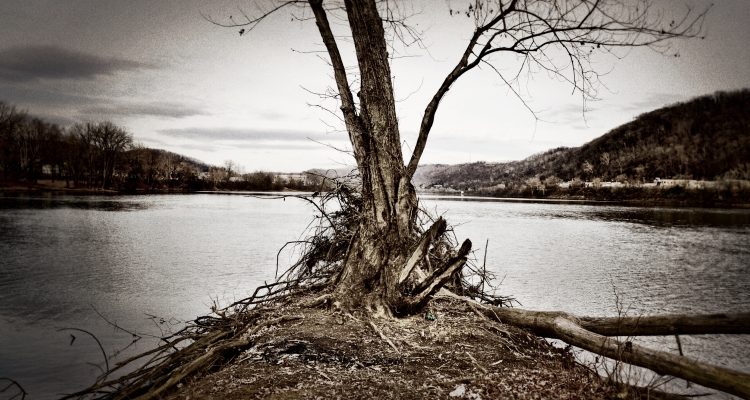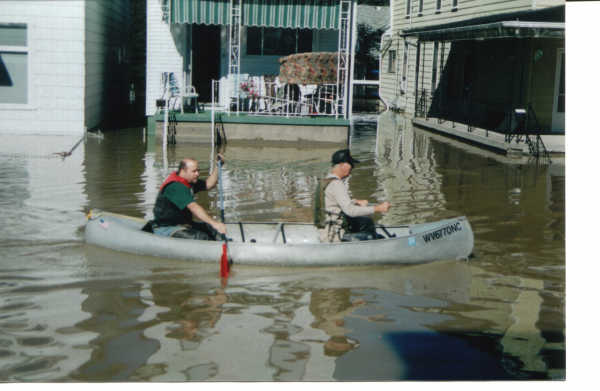By Steve Novotney
Weelunk.com
(Editor’s Note: This is the fourth in a series of articles that will include profiles on each of Wheeling’s established neighborhoods.)
It was intended to be derogatory and sarcastic – maybe even mean.
“Island Rat.”
It was a moniker many believe was coined decades ago by those who did not reside on Wheeling Island and who failed to understand why those glorious stories about jumping off the Aetnaville Bridge, rope-swinging into the Ohio River, playing ball at Bridge Park, Belle Isle, and Jensens, or riding bikes up to “The Point” meant so much to those raised on the Island.

The racetrack on Wheeling Island was opened in the 1866, and has featured horse, harness and greyhound racing since. After the West Virginia Legislature approved video lottery gaming in 1994, Delaware North Inc. added slot machines the next year, and then table gaming was legalized in 2007.
So what did Wheeling Island residents do about the nickname?
They took ownership of it.
T-shirts, annual parties, and even a Facebook page now celebrate the “Island Rat” legacy because that’s what the Island folks do. A proud people living on both the North End and the South End of these 374 acres, Wheeling Island residents have witnessed changes take place – for better and worse – but they are married to their memories and continue fighting for the future.
That’s what they do, and what they’ve always done. It’s a pride thing. Just ask them.
“I have lived 71 of my 72 years on Wheeling Island, and in my opinion there’s no better place in Wheeling to grow up,” said North-end resident Bob Donaghy. “As far as the ‘Island Rat’ thing, it’s a badge of honor for us on the Island. I know it sounds funny to be proud of such a thing, but we are.
“I have seen a lot of changes take place here on the Island, and I see today’s kids growing up a lot differently than I did and the way my three kids did,” Donaghy said. “It’s not just on the Island. It’s more of a national thing, but gone are the days when parents let their kids go until dinner time to do whatever they got themselves into.
“The Ohio River was always the main attraction,” he continued. “Every one of our parents told us to stay away from the river, but none of us listened. We told our kids to stay away from the river, but I know they didn’t listen either. One time I found a stringer of catfish under the old steel bridge, so I took it home not even remembering that I wasn’t supposed to go that close. I got my butt beat for it, but it was worth it.”
It Was a Playground.
Several chapters of the history of the Friendly City involve Wheeling Island, dating back to the Revolutionary War and Civil War eras. Camp Carlisle was a Union Army training fortress situated near today’s Bridge Park; many of the most prominent residents constructed homes along the river shores despite the constant threat of flooding, and the state fairgrounds were located on the South End near the racetrack, featuring the city’s only roller coaster and roller rink.
The entire Island is now an official historic district, and it has been listed on the National Register of Historic Places since 1992.
Today, the coaster is gone, but the former Milam Roller Rink, once dubbed the “Playground of the Ohio Valley since 1932,” still stands and is used currently as a storage facility by Delaware North Inc., parent company of the Wheeling Island Casino.
But for those who were raised on the Island during the 1950s through the late 1980s, these 374 acres offered adventures no other neighborhood in Wheeling could.
Children and adults alike treated the back channel of the Ohio River as their personal lake because of the lack of current, the absence of barges, and the shallow depth levels; they sneaked into the Island Drive-In; most children were “Tigers” while playing baseball and softball; the South End had the Minute Market, and the North End had A&J’s; they swam at the Island Pool, and many children hosted house parties because, well, that’s what they did.
“What I told the kids was that those other teams were not coming over to the Island and beat us,” said Dan Taylor, a lifelong resident who coached Tiger teams for more than 30 years. “We had a lot of pride being from Wheeling Island. It was us against the world. That’s the way we looked at it, and we were pretty successful through the years going about it the way we did.”
The saddest day on Wheeling Island, Taylor said, was when city of Wheeling workers demolished the Belle Isle ballpark in the late 1990s.
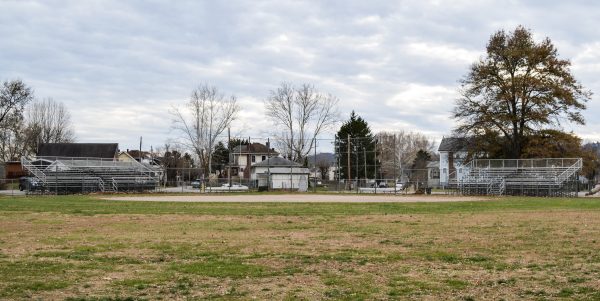
Many Wheeling Island resident miss the original Belle Isle ballpark, a facility described as the Friendly City’s “Yankee Stadium.” The facility, however, was demolished in the late 1990s, and the concrete stands and dugouts were replaced by aluminum bleachers and fencing.
“I stood there with ‘Ducky’ (Don Dusick) with tears rolling down my face,” he said. “There was no reason the city had to do that. It could have been refurbished, but they took it down anyway.
“To the kids of Wheeling Island, that was their Yankee Stadium,” Taylor recalled. “Most of the kids were mad when they got too old to play there because it was a major league ballpark to us, but now it’s gone forever.”
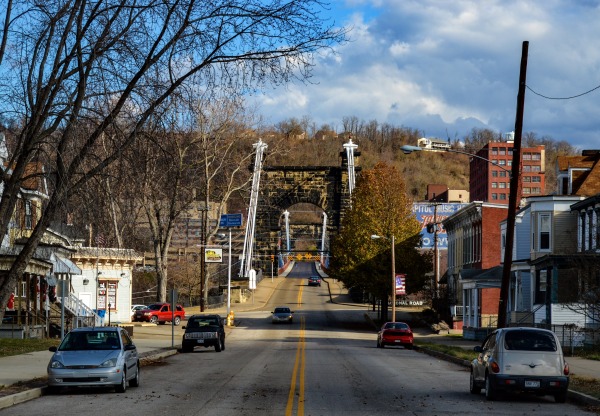
The historic Wheeling Suspension Bridge offered residents of Wheeling Island easy access to downtown Wheeling since opening in 1849.
The historic Wheeling Suspension Bridge served Island residents as the gateway to downtown, still the valley’s mecca of economic activity that offers employment and consumer opportunities.
But once a Wheeling Island child reached adult age, the landscape changed. Those 374 acres became a different kind of playground.
The Merrymint, Mr. Z’s, the Lightning Rod, the I.D.E., P.C.’s, Harbor Lights, Schultzie’s, The Downs, the Stadium Club, the Tropicana, the Yacht Club, and Mac’s Holiday were some of the many taverns that operated along residential streets.
“There wasn’t a lot of drinking and driving on Wheeling Island back in those days because everyone just walked everywhere and left their cars at home,” said Taylor. “Back in those days there wasn’t any reason for Island folks to leave the Island, and most of the city came over here.”
Lynne Walton, a resident of North Wabash Street, moved to Wheeling Island in 1990 to follow employment at the former Applejack’s (now Golden Chopsticks).
“When I first moved to the Island, it seemed like there was a bar on every corner,” she said. “On a normal night, we’d start at whatever place we started, and then we would go to another and another so we could see as many of our neighbors as we could.
“All of the places were crowded, and people had a good time,” she said. “There would be some people there who didn’t live on the Island, but for the most part, it was all of the Island people because there was really no reason to leave the Island.”
The Merrymint burned down and was replaced on adjacent property by the Maroon family’s Abbey’s Restaurant. Mr. Z’s closed, and so did P.C.’s, the Tropicana, the Yacht Club and The Downs. The Stadium Club is now the VooDoo Lounge, the Lightning Rod is now Godfather’s, Harbor Light’s is Abbey’s Parlor, the I.D.E. became the Third Alarm Bar, and Mac’s Holiday is the Island Grill.
“Since I moved to the Island in my late 20s, a lot of places have closed and changed names,” Walton said. “But I no longer see people doing the walking thing like we did back then, and there was something pretty special about that.”
When the Water Flows Over.
The Island residents know their crest levels. Wheeling Island floods less frequently than it used to thanks to the federal government’s creation of watershed reservoirs several years ago, but the Ohio River still overflows her banks often enough that living with the chance of a flood is a way of life.
On Sept. 19, 2004, the Ohio River flood Wheeling Island after cresting at 45.30 feet and allowed residents to canoe the streets of the historic neighborhood. Flooding has occurred on Wheeling Island on 46 occasions since 1902.
Flood stage for Wheeling Island is 36 feet, according to the National Weather Service, and all property owners are aware of how high the waterway must rise before their basements fill with the muddy waters. The highest crest, according to NWS records, was 55.20 feet in March 1936. Since 1902, Wheeling Island has been flooded 46 times.
“When I was a kid, we thought the floods were a lot of fun because we would build rafts and float down the streets,” Taylor remembered. “We had no idea what our parents had to do until we became the adults owning the houses.
“Everybody helped everybody when the floods came. We would go to the houses that were in the low-lying areas first, and then we would go to the houses in the higher areas to make sure everyone got everything out of the way,” he said. “And then we all pulled out our hoses and took care of our basements.”
“That’s when we would get a case of beer and a fifth of whiskey,” said Donaghy. “We’d watch the water go up, and then we would watch the water go down, and at the end the case of beer was gone, and so was the whiskey.
“You had to get your stuff moved, and usually we had enough of a warning that we had time to get it all done,” he said. “Then we’d have to clean the basement and the first floor if the river got that high, but in the end we didn’t suffer any real damage.”
In September 2004, however, the flood warning from the National Weather Service was issued much later than in the past. “In all the years I’ve lived on the Island, that was the worst flood of them all because we didn’t get the warning in time,” Donaghy said.
“I can remember watching that river level come up at least a foot an hour, and I knew there was no way it was going to suddenly stop below flood stage,” he said. “That was a bad one for a lot of us because they couldn’t get the prediction right for whatever reasons.”
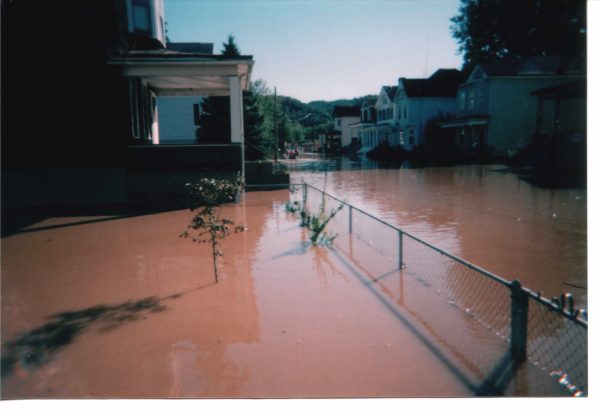
The Ohio River crested at 45.3 feet on Sept. 19, leaving most Island residents surrounded by the river water for two solid days. Once the waters receded, FEMA and Red Cross representatives were present to assist in recovery.
“It flooded again in January 2005, but that time they gave us the amount of time we were used to, so we were able to get everything out of the way,” Donaghy said. “But winter floods are always worse than summer floods because of the temperatures outside. The cold has always made it worse.”
Today, many property owners on Wheeling Island are faced with the changes made with flood insurance through the National Flood Insurance Program. Premiums have skyrocketed, forcing those with mortgages to increase their premium payments from hundreds to thousands of dollars.
“And it makes no sense at all for us on Wheeling Island,” Donaghy said. “No one with the insurance will ever get a dollar from it because of how high the deductibles are and the amount of damage that we actually suffer.”
Stephanie Hall, president of the Wheeling Island Association, said she has seen some Island properties change hands but only because land contracts do not requirement new owners to purchase the insurance.
“That’s definitely a good thing for the future of the Island because a lot of younger families have moved here,” she said. “If that continues to happen, then OK, but that means the property owners have to go that route, and I don’t think all of them are willing to do that.”
Fighting the Fight.
Wheeling Island is one of the oldest neighborhoods in the Friendly City, and many changes to the economy in the Upper Ohio Valley have impacted those residing on these 374 acres. More than 100 dilapidated properties have been demolished during the past 20 years, leading to more vacant plots on the Island today than any resident can recall.
Many large, single-family Victorian houses have been divided into rental apartments as well, and expansions by the Wheeling Island Casino have erased houses along with many memories.
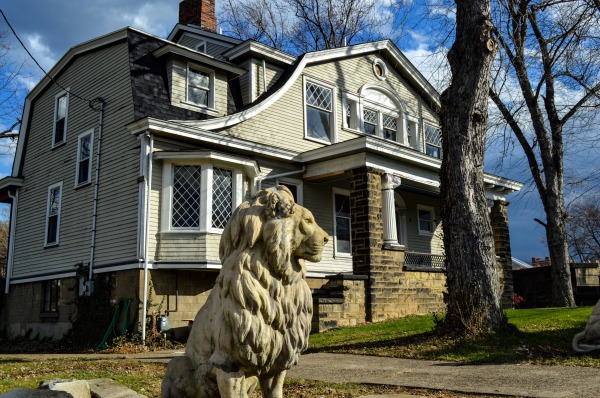
This Wheeling Island home is nestled next to the Wheeling Suspension Bridge and sat vacant for several years before a privately funded restoration project began in 2008.
But that does not mean the current residents have quit making efforts to improve the quality of life on Wheeling Island.
“We are very active with reporting the problems we encounter here on the Island,” explained Hall. “The Wheeling Island Association was formed in 1933 to make sure Island residents were treated as fairly as every other Wheeling resident, and we’re fighting the same fight today.
“I wouldn’t want it any other way, but that’s probably because I’m pretty stubborn,” she said. “We have a lot of older residents who attend our meetings (every third Tuesday of each month), so we need the younger people to get more involved so we can make sure the Island will improve instead it going to downhill.”
Walton is one of those younger residents, and for the past six years she has served as the Island Association’s secretary.
“I wanted to be involved with making changes and to make things better for my family and everyone else’s,” she said. “We do a lot of great things on the Island like the annual cleanup and the steak fry.
“Plus, we do a lot of great things that are directed to our school kids,” she said. “Those things should be important to everyone who lives on the Island. To me, it’s worth the time I put into it because I have seen some very positive things takes place. The people on the Island deserve that because the community is for everyone who lives here.”
Wheeling Police Chief Shawn Schwertfeger described the Wheeling Island Association as, “…an organization that needs to be created in every single neighborhood in this city.”
“Those folks are awesome, and many of them are very, very dedicated to making Wheeling Island a better place,” he said. “Every month the people come to the meetings, and they discuss the issues with Corp. (Ulrich) Utt, and then he goes out and addresses every single issue that’s brought to his attention.
“That’s the way it should work, and the people on the Island are doing the right thing,” the chief said. “Those folks have a lot of quality-of-life issues, and they want them addressed.”
Hall, who moved onto Wheeling Island from the Columbus area in 1964, insisted she will continue battling no matter what others may think of her and her neighbors who reside on these 374 acres because she wishes to watch as the next generation of residents moves in.
“We’re going to fight to protect our neighborhood, and we’re going to make it a better place to live,” she said. “People can call us ‘Rats’ or whatever else if they want. When they do that, they’re just showing their ignorance.”


